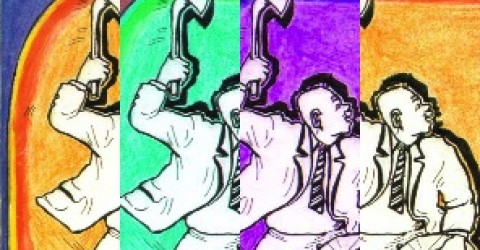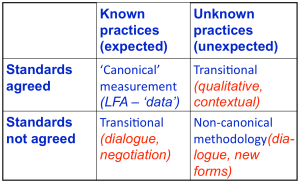Starting up again after the holidays with some philosophy…
Language is an important issue in evaluation I realised just before holidays during the presentations on the INTRAC conference on Monitoring and evaluation.
Just have a look at the words accountability and evaluation…
Where one is developed from the root counting and the other from the word values … you can imagine that they also represent the two main lines in PM&E (Planning, monitoring and evaluation).
Accountability is the issue of the day at the moment: and it’s most of the time narrowed to upward accountability (to the donor) and to counting (measuring) effects…
The introduction of the director of the IOB (Dutch ministry of foreign affairs ‘Inspection for development cooperation’ – what’s in a name…) was completely pushing towards accountability: showing the need for thorough research into the impact of developmental interventions. Roughly speaking: the main aim is to find proof of results in developmental projects, in order to convince politicians to budget for international cooperation. That’s in itself a noble thing: without money there is a lot less possible. But although I consider it necessary, I think its not sufficient.
And there we arrive at the values of evaluation: I think in the end it is more effective to go back to the roots of International Cooperation (and solidarity): somewhere after World War two it was an outcry of ordinary citizens in the richer countries (like The Netherlands) that they found it not compatible with their values to see large part of people in the (then Third) World succumbing to famine and suffering poverty in general. That led to the start of many a ‘development organisation’ like (Oxfam) Novib etc. where the public set aside some of their own wealth in order to show their practical solidarity with people living in poverty.
I see evaluation as a process where we should go back to our joint values and have a look together whether we accomplished what we intended together (as joint stakeholders, first and foremost local people and organisations at the place where project or programmes are running). So there is no space for corruption, there is no space for negligence and inefficiency – no difference here with the accountability paradigm. The difference is in the way of assessment and what’s more in the goal of the assessment. In my view we should focus on a joint understanding of what has been reached and on a joint effort to reach more. Hence my interest in new forms of evaluation (see www.evaluation-5.net) and my constructivist methodological approach (see www.bwsupport.nl).
The results are also different: of the accountability inspection the intended result is to convince politicians (if they can be convinced at all…), of the evaluation the intended result is to do it better together – both local and international stakeholders who negotiate about their joint goals.
But of course that would need a change in paradigm in International Cooperation: the wording International Cooperation in itself is almost entirely that of a state-to-state cooperation: the public itself is less involved nowadays: most investments in solidarity are taxpayers money nowadays, decisions are taken by politicians. If people want to change that we ought to ‘put our money where our mouth is’: more projects need to be directly financed by the people who want to express their solidarity, and should not be left to politicians. Fortunately there are signs here and there (1% club, more solidarity groups, etc.) of a (re-)developing paradigm: it’s not only nostalgia…
So there is a lot in words, thinking through the very intentions behind them….
Next time more practical: quantitative and qualitative impact assessment


